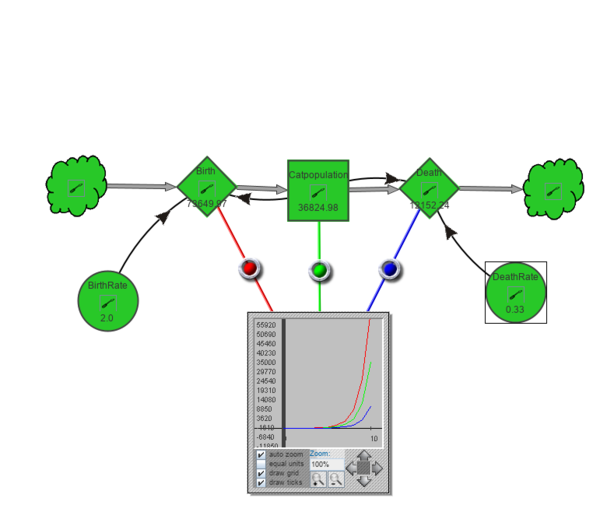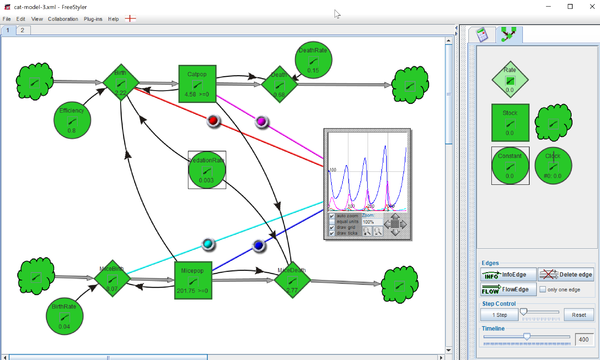System Dynamics (FreeStyler): Difference between revisions
mNo edit summary |
m (→Example) |
||
| Line 11: | Line 11: | ||
[[image: systemdynamics_palette.png|none|thumb|400px|System dynamics palette of FreeStyler]] | [[image: systemdynamics_palette.png|none|thumb|400px|System dynamics palette of FreeStyler]] | ||
== | == Examples == | ||
=== Simulating a single stock growth === | |||
The following example (badly) models a system for cat growth, using yearly increase: | The following example (badly) models a system for cat growth, using yearly increase: | ||
| Line 22: | Line 24: | ||
After 10 years we got almost 36'000 cats. That is impressive. A real model would include food for cats (e.g. mice) and food for mice (e.g. grass) and interactions between these variables. For example, cats starve without mice, mice would eat all the grass if not eaten by cats and starve too. | After 10 years we got almost 36'000 cats. That is impressive. A real model would include food for cats (e.g. mice) and food for mice (e.g. grass) and interactions between these variables. For example, cats starve without mice, mice would eat all the grass if not eaten by cats and starve too. | ||
=== Simulating the interaction between two population === | |||
The following model taken from a [[NetLogo]] library <ref>Wilensky, U. (2005). NetLogo Wolf Sheep Predation (System Dynamics) model. http://ccl.northwestern.edu/netlogo/models/WolfSheepPredation(SystemDynamics). Center for Connected Learning and Computer-Based Modeling, Northwestern University, Evanston, IL. | |||
</ref> simulates growth of mice and cat populations with so-called [https://en.wikipedia.org/wiki/Lotka%E2%80%93Volterra_equations Lotka-Volterra equations]. | |||
* Cat birth are influenced by the number of mice | |||
* Mice death by the number of cats | |||
[[image: system-dynamics-cat-simulation-3.png|none|thumb|600px|Large mice population, cats are growing a cyle = 400]] | |||
[[category:simulation environments]] | [[category:simulation environments]] | ||
Revision as of 14:11, 11 March 2019
This article shortly documents the system dynamics plugin for the Freestyler software. As of Feb 2019 the program is still working under Windows §10 and Ubuntu 10. However, it requires some extra installation efforts described in the Freestyler article. Also, mouse behavior is fairly erratic which is probably due to the fact that Java programs age very badly, even if adapted for the latest Java Runtime. Anyhow, apart from these shortcomings, the program does its job and in addition runs within an environment that includes other interesting educational applications.
Read also:
The system dynamics palette
Examples
Simulating a single stock growth
The following example (badly) models a system for cat growth, using yearly increase:
- We start with a population of two cats
- Birth rate is 2 / year, i.e. on average a couple of cats produces 4 cats / year
- Death rate is 0.33 / year, i.e. on average one out of three cats dies every year.
After 10 years we got almost 36'000 cats. That is impressive. A real model would include food for cats (e.g. mice) and food for mice (e.g. grass) and interactions between these variables. For example, cats starve without mice, mice would eat all the grass if not eaten by cats and starve too.
Simulating the interaction between two population
The following model taken from a NetLogo library [1] simulates growth of mice and cat populations with so-called Lotka-Volterra equations.
- Cat birth are influenced by the number of mice
- Mice death by the number of cats
- ↑ Wilensky, U. (2005). NetLogo Wolf Sheep Predation (System Dynamics) model. http://ccl.northwestern.edu/netlogo/models/WolfSheepPredation(SystemDynamics). Center for Connected Learning and Computer-Based Modeling, Northwestern University, Evanston, IL.


